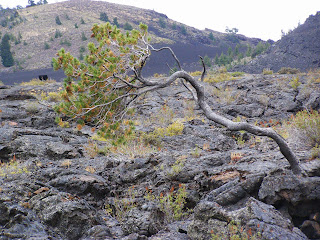 Monday night, Baker City, Oregon. Yesterday we explored Craters of the Moon, a 75-mile national monument park in Idaho where astronauts once trained because of its moon-like barren environment. At Craters of the Moon, a series of volcanos erupted about 15,000 years ago and have continued to erupt about every 2,000 years. The last eruption was 2,000 years ago, so geologists predict the next eruption could be any time, that is geologic time, any time within 100 or 1,000 years. Not exactly next week.
Monday night, Baker City, Oregon. Yesterday we explored Craters of the Moon, a 75-mile national monument park in Idaho where astronauts once trained because of its moon-like barren environment. At Craters of the Moon, a series of volcanos erupted about 15,000 years ago and have continued to erupt about every 2,000 years. The last eruption was 2,000 years ago, so geologists predict the next eruption could be any time, that is geologic time, any time within 100 or 1,000 years. Not exactly next week.After Waterton, Glacier, and Yellowstone, I was not prepared to be wowed. But, wow! We learned about the two types of lava, named after Hawaiian lava, aa (rough rocks) and Pahoehoe (smooth stuff). The pahoehoe forms in long ropy lava tubes, some small and some large enough to form caves. We climbed down into Indian Cave, a very large lava tube that extends about 800 hundred feet long and in places 30 feet high and 50 feet wide. The Shoshone used this particular cave to shelter from the severe snowy winters in their travel across the lava expanse; some of the stones inside the cave may have ceremonial significance, though no additional information is available. The trail was not marked through this cave, and we had to scramble over lava rocks about 20 feet high. Two ravens flew through the cave, and parts were dark, but rest assured, we could see the light at the end of the tunnel. We emerged from the other end to find again no trail back. We hiked now along the top of this gigantic lava tube, using markers for bearings. This was almost too much adventure! We also stood inside a spatter cone, hiked up a cinder cone, and walked around several trails, admiring the tenacity of life, as trees and shrubs somehow find a niche and survive the extremes of temperature and soil.
Today has been the first day of school at Linn-Benton, and I find myself thinking of colleagues and students starting classes for the first time. Instead of teaching, today we spent at the Oregon Trail Discovery Center in Baker City. I have renewed appreciation for those pioneers who headed west in covered wagons. We hiked around the hill outside the Center and stood in the old trail ruts for a moment. All the pictures showed great privation as people mostly walked the 2,000 miles along the Oregon trail. At least I’m back in Oregon, but headed tomorrow for Hell’s Canyon, then north to Spokane. Each day is sunny. May it be so for you! Beth








